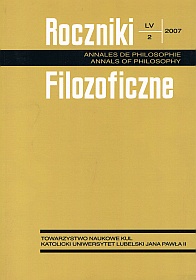Relation between Science and Religion – an Analysis of a Few Approaches
Abstract
There are many different attempts to reconcile or at least to establish a relation between science and religion. The author of this article tries to analyze a few approaches, namely intelligent design theory (id) and the concept of non-overlapping magisteria (noma) created by S. J. Gould. Then the need of seeking the proper ground for a fruitful dialog between science and religion is presented. It seems to be obvious nowadays that id theory is not a good example of any creative dialog between science and religion. Above all the theory is not methodologically correct. noma concept does not seem to be such example as well. It defines religion in a way that it appears rather as a kind of morality. Besides, it sets science and religion completely apart. Gould claims that science and religion are characterized by different areas of investigations. One cannot see any possibility to create a common ground for both magisteria. Despite all difficulties encountered many researchers agree that the creative dialog between those two domains is needed and possible. It is argued here that it is necessary to create a proper ground where both disciplines can cooperate. It should be a ground where as well science as religion retains their methodological autonomy and, on the other hand, where they can provide a coherent picture of reality.
References
Behe M. J. (2002): A response to critics of Darwin’s black box, „Progress in Complexity, Information, and Design” 1.1 (January, February, March), http://www.iscid.org/papers/Behe_ReplyToCritics_121201.pdf
Dembski W. A. (2002): Why natural selection can’t design anything, „Progress in Complexity, Information, and Design” 1.1 (January, February, March), http://www.iscid.org/papers/Dembski_WhyNatural_112901.pdf
DEMBSKI W.A. (2002): Becoming a disciplined science: prospects, pitfalls, and reality check for ID, „Progress in Complexity, Information, and Design” 1.4 (October–December) www.iscid.org/papers/Dembski_DisciplinedScience_102802.pdf
Dembski W. A. (2005): In defense of intelligent design, www.designinference.com/documents/ 2005.06Defense_of _ID.pdf
Forrest B. (2005): From "Creation Science” to „Intelligent Design”: Tracing ID’s creationist ancestry, www.creationismstrojanhorse.com/Tracing_ID_Ancestry.pdf
Forrest B., GROSS P. R. (2004): The evolution of „Intelligent Design”, www.creationisms trojanhorse.com/ST_News_Online.pdf
Gardner M. (1999): The religious views of Stephen Jay Gould and Charles Darwin – special issue: science and religion: conflict or conciliation?, „Skeptical Inquirer” (July–August), www.findarticles.com/p/articles/mi_m2843/is_4_23/ai_55208043
Gould S. J. (1997): Nonoverlapping magisteria, „Natural History” 106 (March), 16-22.
Gould S. J. (2001): Rocks of Ages. Science and Religion in the Fullness of Life, London: Vintage.
Hutchinson I. (2003): Science: Christian and Natural, „Perspectives on Science and Christian Faith” 55(2), 72-79.
Joplin K. H., Shanks N. (1999): Redundant complexity: a critical analysis of Intelligent Design in biochemistry, „Philosophy of Science” 66, 268-282.
Lucas E. (2005): Science and the Bible: are they incompatible?, „Science and Christian Belief” 17(2), 137-154.
Orr A. H. (1996/1997): Darwin v. Intelligent Design (Again), „Boston Review” (December/ January), www.bostonreview.net/BR21.6/orr.html
Orr A.H. (1999): Gould on God. Can religion and science be happily reconciled?, „Boston Review” (October/November), www.bostonreview.net/BR24.5/orr.html
Padget A. G. (2002): Dialectical realism in theology and science, „Perspectives on Science and Christian Faith” 54(3), 184-192.
Peacocke A. R. (1991): Teologia i nauki przyrodnicze, Kraków: Wyd. „Znak”.
Ruse M. (1999): NOMA, www.metanexus.net/metanexus_online/show_article2.asp?ID=3044
Van Till H. J. (1996): Basil, Augustine, and the doctrine of Creation’s Functional Integrity, „Science and Christian Belief” 8(1), 21-38.
Wells J. (1996): Issues in the creation-evolution controversies, „World and I” 11(1), 294.
Witt J. (2005): Zarys historii powstania naukowej teorii inteligentnego projektu, „Na Początku” 13, nr 9-10, 352-362 (tł. Dariusz Sagan).
Wolf J. (2002): Two kinds of causality. Philosophical reflections on “Darwin’s Black Box”, „Progress in Complexity, Information, and Design” 1.4 (October–December), http://www.iscid.org/papers/Wolf_TwoKinds_110802.pdf
Worrall, J.: www.lse.ac.uk/collections/PhilosophyLogicAndScientificMethod/pdf/JohnWorrall?DoesScienceDiscreditReligion%20-final.pdf
Copyright (c) 2007 Roczniki Filozoficzne

This work is licensed under a Creative Commons Attribution-NonCommercial-NoDerivatives 4.0 International License.





